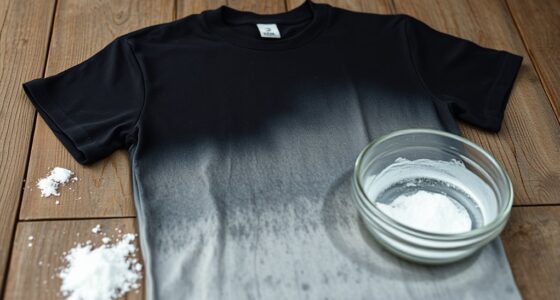Dry cleaning is a gentle, effective way to keep delicate and high-value garments looking their best. Use it for fabrics labeled “dry clean only,” or when dealing with oily stains, embellishments, or intricate details that home washing can’t handle. It helps protect sensitive textiles from damage and extends their lifespan. If you’re curious about when and why to choose dry cleaning, you’ll discover more about how it works and its benefits as you explore further.
Key Takeaways
- Use dry cleaning for delicate fabrics like silk, wool, or garments with embellishments to prevent damage.
- Opt for dry cleaning to effectively remove oily or greasy stains that water-based washing can’t handle.
- Choose dry cleaning for “dry clean only” clothes to preserve their color, shape, and texture.
- Select eco-friendly dry cleaning options to minimize environmental impact and promote sustainability.
- Consider dry cleaning for high-value or special-occasion garments to ensure proper, gentle cleaning and longevity.

Have you ever wondered how dry cleaning keeps your delicate clothes spotless without water? It’s a process that relies on solvents rather than traditional washing, and it’s designed to protect fabrics that can’t withstand the rigors of regular laundering. When you choose dry cleaning, you’re making an investment in fabric care, ensuring that your garments retain their shape, color, and texture over time. But it’s also important to contemplate the environmental impact of this process, as not all solvents used are eco-friendly. Understanding how dry cleaning works can help you make more informed decisions about when and why to use it.
The core of dry cleaning involves using chemical solvents to remove stains and dirt from fabrics. Unlike water-based washing, these solvents don’t penetrate the fibers in the same way, allowing for gentle yet effective cleaning. This method is especially beneficial for delicate fabrics like silk, wool, or those with intricate embellishments that could be damaged in a regular wash. When you opt for dry cleaning, you’re prioritizing fabric care, which extends the lifespan of your clothes and maintains their appearance. It’s a tailored approach that preserves the integrity of sensitive textiles, preventing stretching, shrinking, or color fading that can happen with home laundering.
However, it’s worth noting that traditional dry cleaning processes have a notable environmental impact. Many solvents historically used, such as perchloroethylene (perc), are known to be hazardous to both the environment and human health. These chemicals can contribute to air and water pollution if not managed properly, raising concerns about sustainability. Fortunately, the industry is evolving, and many dry cleaners now use more eco-friendly alternatives, like hydrocarbons or liquid carbon dioxide, which considerably reduce environmental harm. When you choose a cleaner that employs greener methods, you’re actively reducing your ecological footprint while still caring for your garments.
Knowing when to use dry cleaning hinges on the fabric type and the nature of the stain. For instance, oily or greasy stains, delicate fabrics, or items labeled “dry clean only” benefit greatly from professional cleaning. It’s also a good idea to dry clean your more expensive or special-occasion garments to preserve their quality. Conversely, everyday cotton T-shirts or casual wear can often be washed at home, saving you money and reducing environmental impact. Ultimately, balancing these choices involves understanding both the fabric care needs of your wardrobe and the environmental implications of cleaning methods.
In addition, the convenience of remote hackathons has led to innovative approaches in the cleaning industry, including the development of smarter, more sustainable cleaning technologies.
In essence, dry cleaning offers a sophisticated way to care for your most delicate and valuable clothes, but it’s essential to be mindful of the environmental impact. By selecting eco-friendly options and knowing when dry cleaning is necessary, you can keep your wardrobe looking pristine while also being kinder to the planet.
Frequently Asked Questions
Can Dry Cleaning Damage Delicate Fabrics?
Dry cleaning can sometimes damage delicate fabrics if not done properly. You might notice fabric shrinkage or color fading if the process isn’t tailored to your garment’s specific needs. To avoid this, verify your dry cleaner uses gentle methods for delicate materials. Always ask about the cleaning process and check labels to prevent damage like shrinking or fading, keeping your fabrics looking their best.
What Are the Environmental Impacts of Dry Cleaning?
You might not realize it, but dry cleaning’s environmental footprint is worth considering. Traditional methods often rely on chemicals that can harm ecosystems, but eco-friendly solvents and waterless cleaning options are changing that. These innovations reduce chemical waste and water use, making the process gentler on the planet. By choosing eco-conscious dry cleaning, you help protect the environment while keeping your clothes fresh and clean.
How Long Does Dry Cleaning Typically Take?
Dry cleaning typically takes about 1 to 2 hours, depending on the fabric finishing and stain removal techniques needed. When you drop off your clothes, the process involves specialized cleaning methods that target tough stains and delicate fabrics without water. This efficient turnaround guarantees your garments are properly cleaned and ready for pickup quickly, making dry cleaning a convenient choice for maintaining your wardrobe’s quality and appearance.
Is Dry Cleaning Safe for All Types of Stains?
Think of dry cleaning as a skilled alchemist for your clothes. It handles most stains with finesse, but not all. Stain removal depends on the type of stain and fabric compatibility. Some stubborn or oily stains might need special treatment, so check if your fabric is suitable. Trust the pros—they know which stains dry cleaning can tackle without risking damage, ensuring your clothes stay pristine.
How Do I Store Dry-Cleaned Clothes Properly Afterward?
After dry cleaning, you should store your clothes properly to guarantee garment preservation. Use ample space in your closet to prevent wrinkles and damage, and hang delicate items on padded hangers. Keep them in a cool, dry area away from direct sunlight, which can fade fabrics. Following these storage tips helps maintain your dry-cleaned garments’ quality, keeping them fresh and in excellent condition for longer.
Conclusion
So, next time you’re tempted to toss that “dry clean only” shirt into the washing machine, remember—it’s probably better off dry cleaned. Who knew that a simple label could save your favorite clothes from ruin? Irony alert: sometimes, the very process meant to keep your wardrobe pristine actually makes it worse if you try to DIY. So, trust the pros — they might just save your style (and your sanity).









